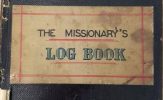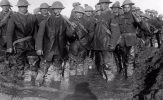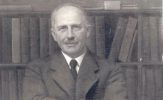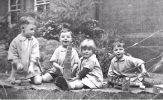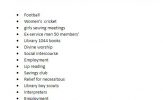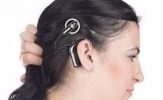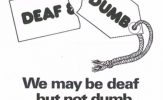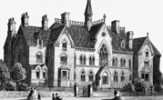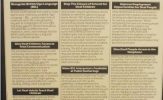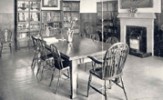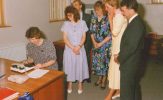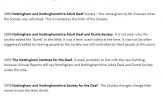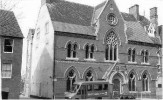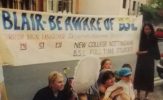History of NDS
673
First defined use of fingers to create an alphabet.
1575
Earliest documented use of sign language in the registry records at St. Martin’s Church, Leicester, of a marriage ceremony between Thomas Tilsye and Ursula Russel.
1620-71
Sir Edward Gostwicke is recorded by the Archdeacon of Bedford as a user of “signes and tokens”.
Sir John Gaudy (1639-1708) and Framlingham Gaudy (1642-1673) are the first Deaf people in the UK reported to have been educated using the manual alphabet and signs.
1680
Publication of George Dalgarno’s Didascalocophus, or The Deaf and Dumb Man’s Tutor, containing a 2-handed manual alphabet.
1735
Robert Parnell was punished by ‘peine forte et dure’ (crushed to death) for not being able to plead in court, considered contempt of court.
1760
Opening of Thomas Briadwood’s Academy for the Deaf in Edinburgh, the first school for the Deaf. The book Vox oculis subjecta, by Francis Green providing information on teaching methods was published in 1783.
1792
Establishment of the London Asylum for the Education of the Deaf and Dumb Poor at Bermondsey, the first public Deaf School in England.
1822
The first adult Deaf Society is established in Glasgow by the then headmaster of the Glasgow Institution for the Deaf and Dumb.
1868
Alderman Cropper set up the Nottingham Institute for the Deaf and ran Bible classes in sign language from his own home.
1880s
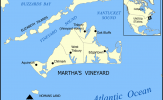
In Martha’s Vineyard in Massachusetts, USA the ratio of Deaf to hearing people was 17.5 times higher than average, so everyone on the island could sign.
1880
The Milan Conference – a gathering of international educationalists of the Deaf declares that oralist education (i.e. spoken word and lip reading) should be the only communication taught in schools. Sign language is suppressed with wide implications for Deaf education.
1883
Nottingham School for Deaf Children, founded at Holly Mount, Clarendon Street. The founder and headmaster was a hearing man, Mr. C. H. Green.
1889
The British Deaf and Dumb Times was published, edited by Charles Gorham (1861-1922), a Deaf man from Leeds.
1890
Mr Greaves, who was deaf himself, took over and re-organised the Institute, which became the Nottingham and Nottinghamshire Adult Deaf Society.
The British Deaf and Dumb Association (now the BDA) is founded in response to the influence of the Milan Congress resolutions.
1891
The Society moved to Friends Meeting House, Park Street.
1896
Mr Blount joined as the first Treasurer and later took over from Mr Greaves. He changed the name to the Nottingham and Nottinghamshire Adult Deaf and Dumb Society and conducted religious services in sign language, interpreted lectures and visited people with serious illnesses.
Mr Green joined as Secretary and was also founder of the School for the Deaf on Clarendon Street. The work of the society is recorded in various Missioners’ Log Books.
1911
The forerunner of the current Action on Hearing Loss (RNID) is launched.
1914-18
World War 1 had a major impact on the services the society provided, as many returning servicemen had suffered hearing loss.
1920s
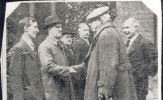
Mr James Forman of Thom Forman & Sons active at the Society.
1922
242 deaf ex-servicemen returned to Nottingham after the First World War and the Deafened Ex-Servicemen’s Association was integrated with the Society.
1924
The first World Games for the Deaf (now Deaflympics) are held in Paris.
1926
The first lip reading classes were formed to help ex-servicemen.
1930
Under the direction of Mr Tweedie, the society bought the old Paton College buildings on Forest Road West and the Grand Opening took place on 29th January 1931.
During the Great Depression of the 1930s, the Employment Bureau was formed to support Deaf people into work.
1931
Nottingham Deaf School move to the new building under the management of Nottingham School Board. They stayed there until 1960.

1930s
During the 1930s the Society developed and ran many activities in their new home.
The Employment Bureau was formed to support Deaf people into work during the depression.
1935
The Society’s reach was extended to include deafened people and the hard of hearing.
1939
During the war the school was evacuated and moved to Southwell. The building was used by the Home Guard and the basement was held as an air raid shelter.
1948
The Society became a registered charity under the National Assistance Act.
1953

150 members watched Queen Elizabeth II’s Coronation on the newly installed TV.
1954
The charity agreed with Nottinghamshire County Council to work as a Welfare Agency, helping people throughout the county.
1956
The first Social Workers for the deaf were employed.
1960
The school at Forest Road West was closed and the children moved to a new school – the Ewing School on Mansfield Road.
1961
The Youth Club was formed.
1966

After nearly 30 years, the Boot and Shoe shop closed. A number of people had gone on to run their own shoe repair shops in the wider community.
1970
A Sports & Social Club was set up in the old library with the newly granted bar licence.
1971
The British Deaf and Dumb Association re-brands itself as the British Deaf Association (BDA).
The first documented reference to British Sign Language (BSL) as the name of the language of Britain’s Deaf Community.
1975
The first BSL classes for hearing people were run in Nottingham. They were delivered by hearing tutors.
1977
Mona Andersson is the first recipient of a bone conduction hearing implant (Baha) in Gothenburg, Sweden.
1978
The charity was re-named the Nottingham and Nottinghamshire Society for the Deaf, and the constitution was updated.
The Lunch Club was formed.
The Warnock Report was published, advocating the integration of Deaf and disabled children into mainstream education. This eventually led to the closure of many residential and specialist schools for the Deaf.
1979
The Social Work Service with Deaf people split off and moved to the Ropewalk, an initial step in separating the roles of social worker and interpreter.
The National Union for the Deaf is formed by a group of radical Deaf people impatient with the lack of progress. One of its key successes was the commission of the BBC See Hear TV series.
1985
Nottinghamshire County Council is the first local authority to create the role of Sign Language Interpreter.
Deaf people abandon The International Congress on the Education of the Deaf, and organise an ‘Alternative Conference’ at Manchester’s Deaf Centre. Deaf historians regard this as the ‘true birth’ of the campaign for the use and the recognition of British Sign Language.
1989
A number of members achieved huge success at the New Zealand Deaf Games. Nick Warnock, from Nottingham Deaf Sports club, won a silver medal in badminton.
1990
Our Centenary Year included a visit from Princess Diana who opened the new office space and met several members, and lots of amazing fundraising efforts.
The Interpreting Unit was formed.
1993
The first implant of a born deaf child in the UK took place.
1994
Major alterations were made to the building and everything was re-located to a Portacabin temporarily.
The Ewing School closed and local deaf children are now taught in ‘Individual Needs Centres’ based in hearing schools, or they’re supported in mainstream schools.
1995
The Society changed its legal status to a Company Limited by Guarantee (alongside its charitable status) and became The Nottinghamshire Deaf Society.
The Disability Discrimination Act is passed.
1997
The Befriending Scheme began. Nottinghamshire County Council adopted a bi-lingual communication policy in education, giving BSL equal status with English.
The Federation of Deaf People (FDP), was set up to campaign about Deaf rights and access to BSL. 4,000 people attend a march for BSL recognition in June 1999.
Nottinghamshire County Council adopted a bi-lingual communication policy in education, giving BSL equal status with English.
1999
The first march for the Campaign for the Recognition of British Sign Language takes place in London.
A new out-of-hours emergency interpreting service was set up at NDS. The one-year trial is still going well today!
2002
The Welfare Rights Service started.
2003
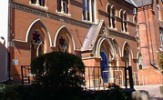
The government recognized BSL as a language in its own right.
2005
The Volunteering Project began.
2008

The Direct Funding Group, made up of deaf and hearing volunteers, was established to raise funds to support the community centre.
2010
The 21st International Congress on the Education of the Deaf, held in Vancouver, Canada finally rejects the decisions of the Milan Conference of 1880.
The Equality Act 2010 has replaced various equality legislation including Disability Discrimination Act 1995.
The constitution was altered to include the East Midlands. BSL Classes at the Society started again.
2016
NDS runs the Hearing Deaf Voices heritage project.






